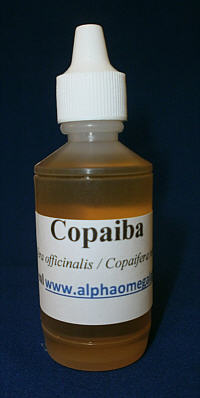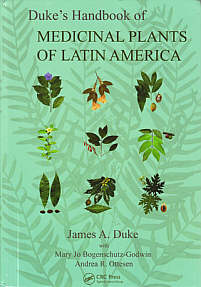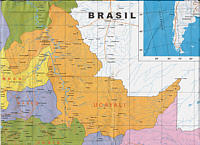|
Analgesic / Anti-Inflammatory Topical, Insect Bites,
Cuts & Abrasions, Anti-bacterial, Anti-cancerous;
Treats Sinusitis, Respiratory Ailments, Stomach Ulcers

Copaiba -- Essential Oil
(Tree resin mix of Copaifera officinalis
with Copaifera reticulata, cold-filtered)
Code 385 -- Price: $8.50
Net : One Fluid Ounce (30 ml.)
Order Now
 Email
Email
 Summarized Description: Summarized Description:
Copaiba is a collective term for a wide variety of small, tropical trees from
the
Caesalpiniaceae subfamily. It's ethnobotanical use is most probably
thousands of years old. In the West, it first appears,
according to
John Uri Lloyd (1898) in manuscripts dating to the
fifteenth century.
 The product we sell comes from
wild-crafted copaiba sap that has been harvested by
Shipibo speaking
associates and collectors of the
Ucayali Region
of Peru.
 Copaiba is used to effectively
treat a wide variety of conditions: wound healing, coagulant (to stop
bleeding), skin sores, insect bites, hemorrhoids, skin and nail fungus (all topically);
and to treat cystitis, chronic diarrhea, and respiratory ailments, such as sinusitis and bronchitis (internal).
 Leslie Taylor reports that researchers
in Tokyo were successful in isolating
" six chemicals (clerodane diterpenes)
in the oleoresin of copaiba in 1994 and tested them against carcinomas in mice to determine their antitumor activity.
One particular compound, called kolavenol, was twice as effective at increasing the lifespan in mice with carcinomas
(by 98%) as the standard chemotherapy drug, 5-Fluorouacil (5-FU) . . .
Interestingly, the in vivo tests provided better anti-tumor effects than in previous test-tube studies." She
goes to report that a team of Spanish researchers "documented copaiba's antimicrobial effects in 2002 also tested
for in vitro antitumor effects. These scientists reported that another phytochemical in the resin, methlyl copalate,
had in vitro activity against human lung carcinoma, human colon carcinoma, human melanoma, and mouse lymphoid /
neoplasm cell lines. Brazilian researchers reported in 2002 that one of copaiba's active chemicals, kaurenoic acid,
also inhibited the growth of human leukemic cells by 95%, and human breast and colon cancer cells by 45% in vitro.
Kaurenoic acid can comprise as much as 1.4% of the natural copaiba oleoresin. ( 1 )

Uses & Protocols
 Indications are provided below.
We recommend that when used topically, it be used sparingly at first --
one drop at a time. Copaiba is, for many people, a mild irritant.
Nothing major -- just noticeable. Use as needed for the condition
being treated.
 Internally, we recommend putting
5 drops in hot water or even green tea and drinking. Our copaiba has
pleasant smell and taste.
Warnings & Contraindications
 Do not use internally if attempting
to conceive, are pregnant, or are lactating.
In certain individuals if used internally to
excess, it can irritate mucous
membrane and cause a cough reflex. The
resin can cause a measles-like rash
in those who are allergic to it. Use
sparingly – initially one drop at a time.
Do not apply in or around the eyes.
 Never take internally
in dosages greater than a teaspoon (5 ml.) Excess dosing can
incur nausea, vomiting, rashes, stomach pain, and lose of equilibrium.
 Similar to garlic, copaiba
imparts a "peculiar odor to the urine and breath" when taken
internally in sufficient quantity. "As of July 2007, the FDA Poisonous
Plant Database listed two titles alluding to toxicity of this species." ( 2 )
Shelf-Life
 Five years or more.

Medicinal Activities
 Further information for practitioners: Further information for practitioners:
World-famous botanist Dr. James Duke attributes the following activities
to this plant (p. 228-230; see hardcopy cover at right),
drawn from the extant literature. (See his graduation for "level of
efficacy" on our amazon traditionals page;
followed by Duke's bibliographic abbreviations (in capital letters),
which we identify
on a separate page.)
- Analgesic (f1; RAI);
- Antacid (f; RAI);
- Antiedemic (1; PR15:476);
- Antiinflammatory (1; MPB; PR15:476; X3352280);
- Antiseptic (f1; JAD; PH2; RAI);
- Antitumor (f; RAI);
- Antitussive (f; RAI);
- Antiulcer (f1; RAI);
- Bactericide (1; PH2; RAI);
- Balsamic (f; MPG);
- Carminative (f; JAD);
- Diuretic (f; RAI);
- Emetic (f; JAD; MPB);
- Emollient (f; HOE; RAI);
- Expectorant (f; JAD; RAI);
- Fungicide (f1; RAI);
- Gastroprotective (f1; RAI);
- Hemostat (f; RAI);
- Hydragogue (f; JAD);
- Hypotensive (f; MPG);
- Laxative (f; MPB);
- Mucolytic (f; RAI);
- Secretolytic (f; RAI);
- Stimulant (f; JAD);
- Stomachic (f; MPG);
- Urinary Antiseptic (1; PH2);
- Vermifuge (f; RAI);
- Vulnerary (f1; MPG; RAI).
Indications
 Further information for practitioners: Further information for practitioners:
Duke provides the following indications for this plant:
- Arthritis (f1; EGG);
- Asthma (f; EGG; MD2);
- Bacteria (f1; PH2; RAI);
- Bleeding (f; RAI);
- Blennorrhagia (f; MPG);
- Bronchosis (f; DLZ; EGG; RAI);
- Burns (f; DLZ; MD2);
- Cancer (f1; EGG; MPG; RAI);
- Cancer, breast (f1; EGG; MPG; RAI);
- Cancer, colon (f1; EGG; MPG; RAI);
- Cancer, lung (f1; EGG; MPG; RAI);
- Carcinoma (2 x 5-Fluorouacil -- 1; RAI);
- Catarrh (f; MPG);
- Chilblains (f; JAD; RAI);
- Colds(f; EGG);
- Colic (f; MD2);
- Constipation (f; MPB; RAI);
- Coughs (f; EGG; RAI);
- Cystosis (f; DLZ; JAD; MAD; RAI);
- Dandruff (f; RAI);
- Dermatosis (f; DAW, EGG, RAI);
- Diarrhea (f; JAD);
- Dislocation (f; DLZ);
- Dropsy (f; JAD; MAD);
- Dysentery (f; MPG; RAI);
- Dysuria (f; MAD);
- Earache (f; EGG);
- Eczema (f; DAW; RAI);
- Edema (f1; PR15:476; RAI);
- Enterosis (f; RAI);
- Fever (f; MAD);
- Flu (f; RAI);
- Fungus (f1; MD2; RAI);
- Gas (f; JAD; RAI);
- Gastrosis (f1; RAI);
- Gonorrhea (f; DAW; JAD; MAD; MD2; RAI);
- Hemorrhoids (f; EGG, MAD);
- High Blood Pressure (f; EGG; MPG; RAI);
- Incontinence (f; DLZ; RAI);
- Indigestion (f; RAI);
- Infection (f1; JAD; PH2; RAI);
- Inflammation (f1; EGG; MPB; PH2; PR15:476; RAI; X3352280);
- Itch (f; EGG; RAI);
- Kidney Stones (1; PH2);
- Leishmania (f; RAI);
- Leukemia (1; RAI);
- Leukorrhea (f; MPG);
- Lymphoma (1; RAI);
- Melanoma (1; RAI);
- Mucososis (f; PH2, RAI);
- Myalgia (f; EGG, RAI);
- Mycosis (f1; EGG; MD2; RAI);
- Nephrosis (f; DLZ; RAI);
- Oliguria (f; RAI);
- Onychosis (f1; RAI);
- Pain (f1; EGG; RAI);
- Phthisis (f; DLZ);
- Pleurisy (f; RAI);
- Pneumonia (f; MPG; RAI);
- Psoriasis (f; MAD; MPG);
- Pulmonosis (f; MAD; PH2, RAI);
- Respirosis (r; RAI);
- Rheumatism (f; DLZ; MAD);
- Sinusosis (f; RAI);
- Sores (f; DLZ; MD2);
- Sore Throat (f; MAD; RAI);
- Swelling (f; RAI);
- Syphilis (f; RAI);
- Tetanus (f; EGG);
- Tonsilosis (f; EGG);
- Tuberculosis (f; RAI);
- Ulcers (f1; EGG; RAI);
- UTIs (f1; PH2; RAI);
- Vaginosis (f; RAI);
- VD (f; IED; MAD; RAI);
- Worms (f; RAI);
- Wounds (f1; DLZ; MD2; MPG; RAI).
Footnotes
- Taylor, Leslie (N.D.); The Healing Power of Rainforest Herbs,
A Guide to Understanding and Using Herbal Medicinals, Square One
Publishers, Garden City Park, NY. ISBN: 0-7570-0144-0. p. 250-255
- Duke, p. 230.
|
 To U.S. Users: To U.S. Users: This product
have not been evaluated by the U.S. Food & Drug Administration.
It is not intended to diagnose, treat, cure, or prevent any disease.
|
 Sourcing From
Sourcing From
The Peruvian
Amazon
 All the materials used to
make our Copaiba are wild-crafted from sources in
the Ucayali Region of Peru.
Dosages &
Ethnobotanical
Usage
 Duke, quite predictably,
provides a "food farmacy potential" score for this plant of, "FNFF=?" ("Very questionable
survival food . . .). Dosages: 0.5 to 1 g. capsule (MAD);
25-30 drops tincture 3x/day (MAD); 5-15 drops copaiba/cup hot water
2-3x/day (RAI).
- Bolivia: Bronchitis, burns, cystosis, dislocated bones,
incontinence, nephrosis, phthisis, rheumatism, sores, syphilis,
and wounds (DLZ).
- Brazil: Bacterial infection, bronchitis, cancer, cough,
cystitis, dandruff, dermatitis, diarrhea, dysentery, enterosis, flu,
gastritis, gonorrhea, high blood pressure, incontinence, infection, inflammation,
nephritis, pain, parasites, pharyngitis, pneumonia, psoriasis, pulmonosis,
respirosis, sinusitis, sores, sore throat, syphilis, tetanus, tonsilitis,
tumors, pulmonosis, respirosis, sinusitis, sores, sore throat, syphilis,
tetanus, tonsilitis, tumors, ulcers, urethrosis, UTIs, vaginosis,
and wounds (MPB; RAI).
- Peru: (using C. reticulata or C. officinalis or C. paupera) --
cicatrizant, gonorrhea, psoriasis, and sores (SAR); bleeding bronchoses,
catarrh, edema, gastrosis, herpes, incontinence, Leishmania, myalgia,
oliguria, pleurisy, sore throat, syphilis, tetanus, tuberculosis, urinary
incontinence, UTIs, vaginosis, and wounds (DAV).
- Panama: Yaviza negroes mix copaiba with honey and put in the mouths
of newly born to impart knowledge and ward off hexes; also used for VD (IED).
|





